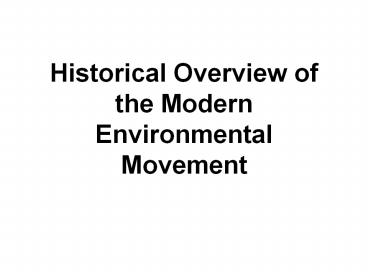Historical Overview of the Modern Environmental Movement - PowerPoint PPT Presentation
1 / 21
Title:
Historical Overview of the Modern Environmental Movement
Description:
Historical Overview of the Modern Environmental Movement In the beginning ~10,000 years ago the human population began to rise after the Neolithic Agricultural ... – PowerPoint PPT presentation
Number of Views:226
Avg rating:3.0/5.0
Title: Historical Overview of the Modern Environmental Movement
1
Historical Overview of the Modern Environmental
Movement
2
In the beginning
- 10,000 years ago the human population began to
rise after the Neolithic Agricultural Revolution. - Humans settled to become farmers instead of local
hunter-gatherers. - This meant managing local resources (food, water,
fuel) sustainably around the settlement
3
Industrial Revolution
- Began in the early 1800s
- Produced goods and services for nearly all, but
demanded the burning of large amounts of trees
and coal. - Required large-scale mining.
- Land was cleared, natural waterways were
polluted, cities became crowded and smoky.
4
James Fenimore Cooper
- 1820s
- Wrote Last of the Mohicans, The Pioneers, and The
Prairie. - Natural resources are not infinite.
- Nature must be preserved for future generations.
- Pollution and other activities endanger life on
Earth.
5
Ralph Waldo Emersonand Henry David Thoreau
- Wrote about a reverence for the natural world.
- Described an almost mystical experience.
- Transcendentalists.
- Not a scientists.
6
1900-1960Environmental Awareness Grows
7
Theodore Roosevelt
- U.S. President 1901-9
- Instrumental in founding the U.S. Forest Service
and National Parks. - Believed the health of the nation depended upon
the health of the land.
8
John Muir
- Perhaps the first preservationist.
- Believed that nature for be preserved for its own
sake, not to provide resources for humans. - Said nature is a mirror reflecting the Creator.
- Founded the Sierra Club in 1892.
- Fought for the preservation of Yosemite National
Park.
9
Roosevelt and Muir in Yosemite 1903
10
Gifford Pinchot
- A conservationist.
- Believed that forests should be used both to
conserve the environment and to provide resources
for humans. - Muir and Pinchot disagreed over the Hetch Hetchy
Dam project.
11
William Hornaby
- 1913 wrote the influential book, Our Vanishing
Wildlife. - 1914 Martha, the last passenger pigeon, died in
the Cincinnati Zoo.
12
The Dust Bowl
- In the 1930s, in the grass plains of North
America. - Drought and winds turned the farms into dust and
ruined agriculture. - Likely caused by a combination of poor farming
practices and a severe drought.
13
The Green Revolution
- 1940s 1960s
- Modern agriculture boosted food production
significantly. - Required machinery and tremendous amounts of
fossil fuel. - New crops varieties were developed and fertilizer
and pesticide use rose sharply. - World population grew to about 3 billion.
14
Aldo Leopold
- Wrote A Sand County Almanac in 1949.
- Widely considered the most important
environmental book ever written. - Argues that we have an ethical responsibility to
be good stewards of the land.
15
1960sModern Environmental Movement Gains
Momentum in U.S.
16
Rachel Carson
- Wrote Silent Spring.
- Warned of the effects of pesticides.
- As a result, DDT was banned.
- May have been a mistake, as DDT is an effective
means to prevent malaria.
17
1970s
- The movement goes global.
- A number of prominent NGOs (private
organizations) were formed. - Friends of the Earth and Greenpeace were both
established in 1971. - The first UN Earth Summit was held in Stockholm,
Sweden in 1972. - CITES Treaty 1975
- Many controversial environmental ideas were
explored.
18
1980s
- 1984 Union Carbide pesticide plant released 40
tonnes of methyl isocyanate gas, immediately
killing nearly 3,000 and ultimately killing
15,000 people. - 1986 Chernobyl nuclear power plant in Ukraine
exploded. 4,000 immediate deaths, estimated
30,000 deaths ultimately.
19
1980s
- 1987 Montreal Protocol was signed, requiring
nations to reduce CFC emissions. - 1988 UN forms the Intergovernmental Panel on
Climate Change (IPCC). - 1989 Exxon Valdez runs aground and spills 10.8
million gallons of crude oil into Alaskas
Prudhoe Bay.
20
1990s
- 1992 Earth Summit in Rio de Janeiro, Brazil.
- Focused on global warming and global economics.
- Green awareness became widespread in developed
nations. - Captain Planet and the Planeteers.
- Green Party gains power in Europe.
- Ecotourism thrives.
21
2000s
- 2002 Earth Summit in Johannesburg, South Africa
was largest to date. - Focused on 5 areas
- Water and sanitation
- Energy
- Health
- Agriculture
- Biodiversity
- Kyoto Protocol became a legal requirement in 2005.































